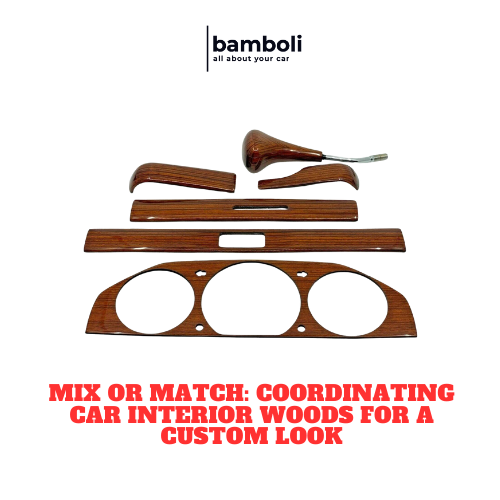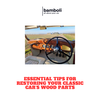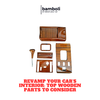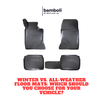Mix or Match: Coordinating Car Interior Woods for a Custom Look

Mix or Match: Coordinating Car Interior Woods for a Custom Look
When it comes to customizing your car's interior, the choice of wood can make a big impact on the overall look and feel of your vehicle. Coordinating different types of wood can add a sophisticated and unique touch to your car's interior. Whether you're looking to match the existing wood trim in your car or want to mix and match different wood finishes for a custom look, there are plenty of options to choose from. From mahogany to walnut, there's a wide array of wood choices that can elevate the style of your car's interior.
Main Points
- Coordinating different wood types for a custom look
- Matching existing wood trim in your car
- Exploring a wide array of wood choices, including mahogany and walnut
Exploring the Impact of Different Wood Finishes on Car Interiors
When it comes to car interiors, the choice of wood finish can have a significant impact on the overall look and feel of the vehicle. Different wood finishes can create a range of aesthetics, from classic and sophisticated to modern and sleek. In this article, we will explore the influence of various wood finishes on car interiors and how they can enhance the driving experience.
The Importance of Wood Finishes
Auto parts accessories such as wood trims and accents play a crucial role in enhancing the design and luxury of car interiors. The choice of wood finish can reflect the owner's personal style and contribute to the overall ambiance of the vehicle. Whether it's a traditional polished wood or a contemporary matte finish, the selection of wood can make a significant difference in the interior appeal.
Types of Wood Finishes
There are several popular car roof accessories wood finishes that are commonly used in car interiors, each with its own unique characteristics:
- Polished Wood: This classic finish is known for its high shine and luxurious appearance. It brings a sense of elegance to the car interior, making it a popular choice for luxury vehicles.
- Matte Wood: A modern and understated option, matte wood finish provides a more subtle and contemporary look to the car interior. It is often preferred in minimalist and sleek car designs.
- Burl Wood: With its intricate grain patterns, burl wood finish adds a touch of sophistication and uniqueness to the interior. It is a popular choice for those seeking a one-of-a-kind aesthetic.
Each of these wood finishes vehicle roof racks has its own charm and can significantly impact the overall atmosphere of the car interior.
Enhancing the Driving Experience
Aside from aesthetics, the choice of wood finish can also contribute to the overall driving experience. For example, a polished wood finish may create a more formal and luxurious ambiance, while a matte wood finish can provide a more contemporary and relaxed feel. The right wood finish can enhance comfort and create a sense of refinement within the vehicle.
In conclusion, the impact of different wood finishes on car interiors is undeniable. From influencing the overall design and ambiance to enhancing the driving experience, the choice of wood finish plays a crucial role in creating an inviting and stylish car interior.
Creating a Cohesive Aesthetic: Harmonizing Wood Accents in Your Car
When it comes to creating a cohesive aesthetic in your car, paying attention to the small details can make a big difference. One of the key elements that can contribute to a harmonious overall look is the use of wood accents. Incorporating wood into your car's interior design can add warmth, sophistication, and a touch of luxury. In this article, we'll explore some creative ways to harmonize wood accents in your car for a truly polished and cohesive aesthetic.
Choosing the Right Wood Finish
The first step in harmonizing wood accents in your car is to choose the right wood finish. Whether you prefer a rich, dark walnut or a lighter, honey-colored birch, selecting a wood finish that complements the overall color scheme of your car's interior is crucial. Pay attention to the tones and undertones in your car's upholstery, dashboard, and trim, and choose a wood finish that will harmonize effortlessly with these elements.
Coordinating with Other Materials
Wood accents can create a stunning visual impact in your car, but they shouldn't stand alone. To create a cohesive aesthetic, it's essential to coordinate your wood accents with other materials in the car. For example, pairing wood with metal accents can create a modern, industrial look, while combining it with leather upholstery can lend a sense of luxury and sophistication.
Attention to Detail
Finally, paying attention to the smallest details can make a big difference in harmonizing wood accents in your car. Whether it's choosing wood-trimmed accessories, such as gear shift knobs or steering wheels, or incorporating small touches of wood into the car's interior, such as cup holders or door handles, these subtle elements can tie the overall aesthetic together in a seamless and sophisticated way.
By paying attention to the wood finish, coordinating with other materials, and focusing on the details, you can create a truly cohesive aesthetic in your car that harmonizes wood accents with the rest of the interior design. Whether you prefer a classic, traditional look or a more modern and sleek style, incorporating wood accents can add a touch of warmth and sophistication to your car's interior.
The Art of Blending Multiple Wood Types in Car Interior Design
When it comes to car interior design, the use of wood is a classic and timeless choice. However, the art lies in the blending of multiple wood types to create a sophisticated and harmonious look.
One of the keys to achieving this is to understand the characteristics of different wood types. For example, cherry wood is known for its rich, reddish tones, while oak has a more natural and rustic appearance. By combining these two types, a designer can create a multi-dimensional and visually interesting interior.
Understanding the Grain
Another aspect to consider is the grain of the wood. Some types, such as mahogany, have a very pronounced grain, while others, like walnut, have a more subtle and uniform grain. By mixing and matching wood types with different grain patterns, a designer can add depth and texture to the interior space.
Creating Contrast
Contrast is also an important element in the art of blending multiple wood types. For example, pairing a dark wood like ebony with a lighter wood such as maple can create a striking and visually appealing contrast. This can be further enhanced by using different finishes, such as matte and gloss, to highlight the individual characteristics of each wood type.
In conclusion, the art of blending multiple wood types in car interior design requires a deep understanding of the characteristics of each type, as well as a keen eye for creating harmony and contrast. When done successfully, the result is a interior that is not only visually stunning, but also timeless and elegant.
Elevating Your Car's Style: Mixing and Matching Wood Finishes for a Custom Look
When it comes to customizing your car, paying attention to the interior details can make a huge difference. One way to elevate your car's style is by mixing and matching different wood finishes. This can create a unique and personalized look that sets your vehicle apart from the rest. In this article, we'll explore some tips and tricks for effectively mixing and matching wood finishes to achieve a custom look for your car's interior.
Understanding Wood Finishes
Before you start mixing and matching wood finishes, it's important to understand the different types available. Some common wood finishes used in car interiors include:
- Walnut: Known for its rich, dark color and elegant grain pattern.
- Maple: Lighter in color with a subtle grain, often used for a more modern look.
- Cherry: A warm, reddish-brown hue with a smooth finish, perfect for adding a touch of sophistication.
Each type of wood finish has its own unique characteristics, and understanding these differences will help you effectively mix and match them for a custom look.
Mixing and Matching Tips
Once you have a good understanding of the different wood finishes, you can start experimenting with mixing and matching them in your car's interior. Here are some tips to help you achieve a cohesive yet custom look:
- Balance: Aim for a balanced combination of wood finishes. For example, if you have a walnut dashboard, consider adding maple accents on the door panels or cherry trim around the center console.
- Contrast: Don't be afraid to mix finishes that contrast with each other. A mix of light and dark wood finishes can create a visually appealing and dynamic interior.
- Consistency: While mixing and matching, it's important to maintain a level of consistency. Choose finishes that complement each other and create a cohesive overall look.
Customization Ideas
Here are some specific customization ideas to get you started:
|
Area |
Wood Finish |
|
Dashboard |
Walnut |
|
Door Panels |
Maple |
|
Center Console |
Cherry |
By incorporating different wood finishes in these specific areas, you can achieve a custom look that reflects your personal style and preferences.
Overall, mixing and matching wood finishes is a great way to elevate your car's style and create a custom look that is uniquely yours. With a thoughtful approach and attention to detail, you can transform your car's interior into a sophisticated and personalized space.
Practical Tips for Coordinating Car Interior Woods to Achieve a Polished Appearance
When it comes to creating a polished and sophisticated look for your car's interior, coordinating different types of wood can make a significant impact. Whether you have a classic car with original wood trim or a modern vehicle with wood accents, it's essential to consider how to blend different wood tones and textures seamlessly. Here are some practical tips to help you achieve a polished appearance:
- Consider the Overall Aesthetic
Before making any decisions about coordinating car interior woods, take a moment to consider the overall aesthetic you want to achieve. Do you prefer a warm and traditional look, or are you aiming for a more modern and sleek appearance? Understanding the style you are going for will guide your choices when it comes to coordinating different wood elements in the car's interior.
- Pay Attention to Wood Grain and Texture
When coordinating different wood elements, pay close attention to the grain and texture of the wood. Ideally, the wood grains should complement each other, creating a cohesive and harmonious look. If you're working with original wood trim, consider using similar wood species for any additional accents to maintain a consistent texture throughout the interior.
- Use Contrast to Create Visual Interest
While it's essential to coordinate different wood elements, don't be afraid to use contrast to create visual interest. Mixing lighter and darker wood tones can add depth and dimension to the car's interior, making it more visually appealing. Just be sure to strike a balance and avoid overwhelming the space with too many conflicting wood finishes.
By following these practical tips and paying attention to the overall aesthetic, wood grain, and contrast, you can effectively coordinate car interior woods to achieve a polished appearance. Whether you're restoring a classic car or customizing a modern vehicle, the careful coordination of wood elements can elevate the overall look and feel of the interior.
Innovative Approaches to Incorporating Diverse Wood Elements in Car Interiors
The use of wood in car interiors has always been a symbol of luxury and sophistication. But with innovative approaches and new technologies, car manufacturers are finding diverse ways to incorporate wood elements into their designs, creating a harmonious blend of nature and modernity.
One of the innovative approaches is the use of reclaimed wood from old structures, such as barns and factories. This not only adds a unique character to the car interior but also promotes sustainability and environmental consciousness. Incorporating reclaimed wood in car interiors is a testament to the concept of giving new life to old materials.
Another approach is the use of wood veneers that are treated with advanced coatings to enhance durability and resistance to wear and tear. These treated wood veneers bring a touch of elegance to car interiors while ensuring longevity and low maintenance.
Integration of High-Tech Features with Wood Elements
In addition to the aesthetic appeal, car manufacturers are also integrating high-tech features with wood elements to create a seamless blend of tradition and innovation. For instance, touch-sensitive wooden panels that control the car's infotainment system and climate settings are becoming increasingly popular, adding a futuristic element to the classic material.
|
Wood Element |
Innovative Application |
|
Reclaimed Wood |
Used for interior trims and accents |
|
Wood Veneers |
Treated for durability and integrated into dashboards |
|
Touch-Sensitive Panels |
Control infotainment and climate settings |
"Integrating diverse wood elements in car interiors not only adds a touch of elegance but also reflects a commitment to sustainability and innovation." - Automotive Design Magazine
Frequently Asked Questions
What are the benefits of using a roof rack?
A roof rack provides extra storage space for bulky items such as luggage, sports equipment, or outdoor gear, freeing up space inside the vehicle.
How do I choose the right roof rack for my vehicle?
Consider the type of load you will be carrying, the vehicle's roof type, and whether you want a permanent or temporary mounting solution. It's also important to check the weight capacity and compatibility with your vehicle model.
What are roof rails and how are they different from cross bars?
Roof rails are the factory-installed rails along the length of the vehicle's roof, while cross bars are the horizontal bars that attach to the roof rails to provide a base for mounting accessories. Roof rails are generally fixed in position, while cross bars can be adjusted to accommodate different loads.
Do floor mats serve any purpose beyond aesthetics?
Yes, floor mats protect the vehicle's carpet from dirt, spills, and wear, making it easier to clean and maintain the interior. They also add a layer of insulation and reduce road noise.
Where can I find classic car parts and vintage auto accessories?
There are specialized retailers, online marketplaces, and salvage yards that cater to classic car enthusiasts. You can also attend car shows, auctions, and swap meets to find rare and vintage auto parts.
-
Posted in
Accessories, Advantages, Bamboli LTD Review, Installation, Interior, Wood




